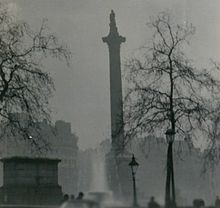Air pollution in the United Kingdom
| This article may require cleanup to meet Wikipedia's quality standards. The specific problem is: article needs expanding. It does not properly represent the topic.. (June 2012) |
Air pollution in the United Kingdom. Air quality targets set by the Department for Environment, Food and Rural Affairs (DEFRA) are mostly aimed at local government representatives responsible for the management of air quality in cities, where air quality management is the most urgent.
Contents[hide] |
[edit]Published information
The UK has established an air quality network where levels of the key air pollutants[1] are published by monitoring centres.[2] Air quality in Oxford, Bath and London[3] is particularly poor. One controversial study[4] performed by the Calor Gas company and published in the Guardian newspaper compared walking in Oxford on an average day to smoking over sixty light cigarettes.
More precise comparisons can be collected from the UK Air Quality Archive[5] which allows the user to compare a cities management of pollutants against the national air quality objectives[6] set by DEFRA in 2000.
Localized peak values are often cited, but average values are also important to human health. The UK National Air Quality Information Archive offers almost real-time monitoring of "current maximum" air pollution measurements for many UK towns and cities.[7] This source offers a wide range of constantly updated data, including:
- Hourly Mean Ozone (µg/m³)
- Hourly Mean Nitrogen dioxide (µg/m³)
- Maximum 15-Minute Mean Sulphur dioxide (µg/m³)
- 8-Hour Mean Carbon monoxide (mg/m³)
- 24-Hour Mean PM10 (µg/m³ Grav Equiv)
DEFRA acknowledges that air pollution has a significant effect on health and has produced a simple banding index system[8] that is used to create a daily warning system that is issued by the BBC Weather Service to indicate air pollution levels.[9] DEFRA has published guidelines for people suffering from respiratory and heart diseases.[10]
[edit]The Great Smog of 1952
Main article: Great Smog of 1952
Early in December 1952, a cold fog descended upon London. Because of the cold, Londoners began to burn more coal than usual. The resulting air pollution was trapped by the inversion layer formed by the dense mass of cold air. Concentrations of pollutants, coal smoke in particular, built up dramatically. The problem was made worse by use of low-quality, high-sulphur coal for home heating in London in order to permit export of higher-quality coal, because of the country's tenuous postwar economic situation. The "fog", or smog, was so thick that driving became difficult or impossible.[11] The extreme reduction in visibility was accompanied by an increase in criminal activity as well as transportation delays and a virtual shut down of the city. During the 4 day period of fog, at least 4,000 people died as a direct result of the weather.[12]
See also
[edit]References
- ^ The Department for Environment, Food & Rural Affairs (DEFRA): Air Pollution
- ^ LAQM Air Quality Management Areas
- ^ London
- ^ Taking the Oxford air adds up to a 60-a-day habit (a newspaper article in The Guardian)
- ^ UK Air Quality Archive
- ^ UK National Air Quality Objectives
- ^ Current Air Pollution Bulletin
- ^ Air Pollution Bandings and Indexes
- ^ BBC Weather Service
- ^ Air Pollution - What it means for your health
- ^ Nielsen, John (2002-12-12). "The Killer Fog of ’52: Thousands died as Poisonous Air Smothered London". National Public Radio.
- ^ "On this Day: 1952 London Fog Clears After days of Chaos". BBC News. 2005-12-09.
[edit]External links
| Wikimedia Commons has media related to: Air pollution |







0 comments:
Post a Comment